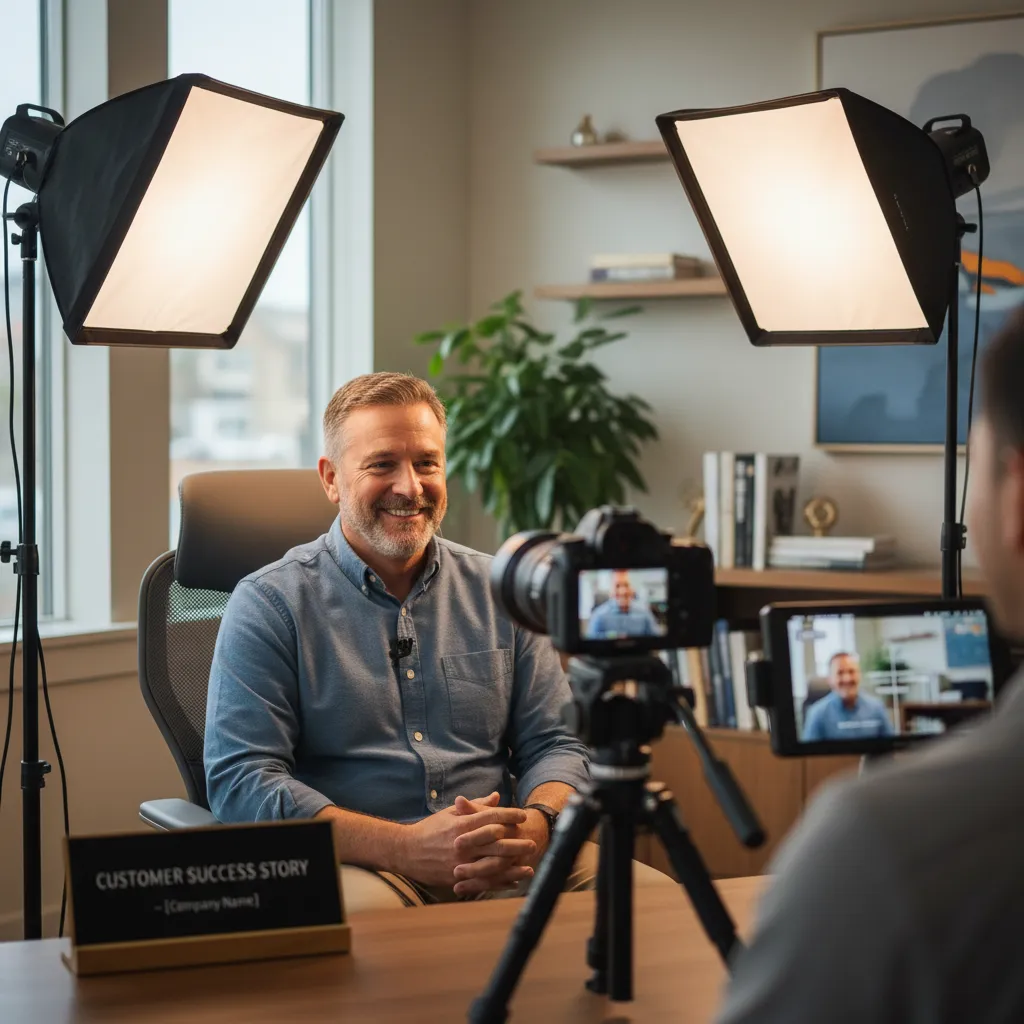
Video Testimonials: Authentic Customer Stories That Drive Conversions and Build Trust
Harnessing the Power of Authentic Customer Stories
Video testimonials represent the most persuasive form of social proof, transforming satisfied customer experiences into compelling marketing assets that influence purchasing decisions more effectively than any traditional advertising approach. At M&M Communications, we've produced video testimonials for diverse clients from hospitality to technology sectors, understanding that successful testimonials aren't just about capturing positive reviews—they're about creating inspirational and magical stories that showcase genuine transformation and authentic value delivery.
Understanding Video Testimonial Psychology
Video testimonials leverage fundamental psychological principles that drive human decision-making: social proof, authority, and emotional connection. When prospects see real people sharing authentic experiences, they envision themselves achieving similar outcomes, creating powerful motivation for action.
Unlike written reviews or ratings, video testimonials convey emotion, sincerity, and credibility through vocal tone, facial expressions, and body language. These nonverbal elements communicate trustworthiness more effectively than text-based testimonials, making video format particularly valuable for high-consideration purchases or complex services.
The most effective video testimonials focus on customer transformation rather than product features, allowing prospects to connect emotionally with outcomes and benefits that matter most to their specific situations and goals.
Strategic Testimonial Planning and Collection
Identifying Ideal Testimonial Candidates
Select testimonial participants based on their transformation stories, target audience representation, and communication comfort levels rather than simply choosing your most enthusiastic customers. The best testimonials come from customers who've experienced significant, measurable improvements through your products or services.
Consider demographic representation that mirrors your target market, including industry segments, company sizes, geographic locations, and decision-maker roles. Diverse testimonials enable prospects to find relatable stories that resonate with their specific circumstances.
Prioritize customers who can articulate their experiences clearly and feel comfortable sharing personal or professional details on camera. Natural storytellers often create more engaging testimonials than customers who are merely satisfied but less expressive.
Pre-Interview Research and Preparation
Conduct thorough pre-interviews to understand each customer's complete journey: initial challenges, decision-making process, implementation experience, and specific outcomes achieved. This research enables you to guide interviews toward the most compelling story elements.
Identify specific metrics, improvements, or transformations that can be quantified and communicated effectively. Concrete results—cost savings, time improvements, revenue increases—provide credible evidence that supports testimonial claims.
Understand each customer's communication style and comfort level with different interview formats. Some customers excel in conversational interviews, while others prefer more structured question-and-answer formats.
Professional Video Testimonial Production
Technical Setup and Equipment
Professional video testimonials require high-quality audio and video that reflects positively on your brand while ensuring testimonial authenticity. Poor production quality can undermine credibility and make testimonials appear staged or unrealistic.
Use professional cameras (DSLR or mirrorless) with quality lenses that provide shallow depth of field, isolating subjects from backgrounds while creating visually appealing compositions. Avoid overly complex setups that might intimidate testimonial participants.
Audio quality often determines testimonial effectiveness more than video quality. Use lavalier microphones for clear dialogue capture, backup recording systems to prevent technical disasters, and acoustic treatment to minimize echo and background noise.
Lighting Design for Authenticity
Professional lighting should enhance subject appearance without creating obviously artificial or overly polished looks that might seem inauthentic. Soft, flattering lighting that mimics natural window light often works best for testimonial credibility.
Consider shooting locations that reinforce testimonial authenticity: customer offices, homes, or relevant business environments rather than obvious studio setups. Natural environments support testimonial believability while providing context for customer stories.
Maintain consistent lighting throughout interviews to ensure professional appearance during editing and post-production processes.
Interview Techniques for Compelling Testimonials
Building Comfort and Trust
Create relaxed, conversational environments where customers feel comfortable sharing personal or professional experiences authentically. Begin with casual conversation before formal recording to help participants relax and warm up to the camera.
Explain the interview process, intended usage, and approximate duration to reduce anxiety and enable participants to prepare mentally for the experience. Transparency builds trust and improves testimonial quality.
Allow participants to review and approve final testimonials before public use, providing confidence that their words won't be taken out of context or used inappropriately.
Strategic Questioning Techniques
Structure interviews around customer journey phases: situation before your solution, decision-making process, implementation experience, and specific outcomes achieved. This chronological approach creates natural story arcs that prospects can easily follow and relate to.
Use open-ended questions that encourage detailed responses rather than yes/no answers. Instead of "Are you satisfied with our service?" ask "How has our service changed your daily operations?" or "What specific improvements have you noticed?"
Follow up on general statements with requests for specific examples, metrics, or details that make testimonials more credible and compelling. Specific details create believability that general praise cannot achieve.
Handling Nervous or Camera-Shy Participants
Some excellent testimonial candidates may feel uncomfortable on camera despite having compelling stories to share. Use multiple takes, provide prompting questions, and create relaxed environments that encourage natural expression.
Consider alternative formats for camera-shy participants: audio testimonials with supporting visuals, written testimonials with photos, or brief, highly edited testimonials that minimize on-camera time while capturing key messages.
Offer to share questions in advance for participants who prefer preparation time, but encourage natural, conversational responses rather than overly rehearsed presentations.
Legal Considerations and Consent Management
Comprehensive Release Agreements
Obtain detailed written consent that covers all intended uses of testimonial content: website placement, social media sharing, advertising campaigns, trade show displays, and future marketing materials. Comprehensive agreements prevent legal complications and usage restrictions.
Include provisions for editing, excerpting, and repurposing testimonial content across different formats and platforms. Marketing campaigns often require multiple versions of testimonial content for different contexts and audiences.
Consider compensation or incentive agreements that appreciate customer time and effort while ensuring legal compliance with testimonial disclosure requirements in your jurisdiction.
Privacy and Confidentiality Protection
Respect customer privacy preferences regarding company names, specific metrics, or sensitive business information that shouldn't be publicly disclosed. Offer options for anonymous testimonials or general references that protect confidential details.
Establish clear guidelines about information that can and cannot be shared publicly, ensuring testimonials provide valuable social proof without compromising customer relationships or business confidentiality.
Editing and Post-Production Strategy
Maintaining Authenticity While Improving Flow
Edit testimonials to improve pacing and clarity while maintaining authentic voice and natural delivery. Remove unnecessary pauses, filler words, and repetition without creating obviously edited or artificial-sounding results.
Preserve emotional moments, genuine enthusiasm, and natural expressions that communicate sincerity. Over-editing can remove the authentic elements that make video testimonials more powerful than scripted advertising content.
Consider multiple testimonial versions: full interviews for detailed case studies, short excerpts for social media, and specific quotes for targeted marketing campaigns.
Supporting Visual Elements
Include supporting visuals that reinforce testimonial claims without overwhelming the speaker: relevant screenshots, product demonstrations, company logos, or results charts that provide context and evidence.
Use lower thirds and graphics that identify speakers and their companies while providing credibility indicators like job titles, company sizes, or industry affiliations that help prospects relate to testimonial participants.
Maintain visual consistency with brand guidelines while ensuring testimonials feel authentic rather than overly branded or commercial.
Strategic Testimonial Integration
Website and Landing Page Optimization
Place video testimonials strategically throughout customer journey touchpoints: homepage for credibility building, product pages for purchase decision support, and checkout processes for final conversion encouragement.
Create testimonial-focused landing pages for specific campaigns or target audiences, organizing testimonials by industry, use case, or customer segment to maximize relevance and impact.
Implement testimonial rotation systems that display different customer stories to repeat visitors, providing fresh social proof while accommodating different prospect preferences and situations.
Social Media and Multi-Platform Distribution
Adapt testimonials for different social media platforms: short excerpts for Instagram Stories, professional testimonials for LinkedIn, and engaging clips for Facebook and YouTube. Each platform requires different approaches while maintaining testimonial integrity.
Create testimonial campaigns that feature customer stories across multiple touchpoints and timeframes, building comprehensive social proof rather than relying on single testimonial exposures.
Measuring Testimonial Impact and ROI
Conversion Tracking and Analysis
Implement tracking systems that measure testimonial impact on conversion rates, lead quality, and sales cycle length. Compare performance metrics before and after testimonial implementation to quantify business value.
Track engagement metrics for video testimonials: view completion rates, click-through rates, and social sharing behavior that indicate testimonial effectiveness and audience resonance.
Monitor lead quality improvements and sales conversion improvements that may result from testimonial social proof, even if direct attribution proves challenging to measure precisely.
Customer Feedback and Testimonial Effectiveness
Survey prospects and customers about testimonial influence on their decision-making processes. Understanding how testimonials affect purchase decisions enables optimization of testimonial strategy and content development.
Analyze which testimonials perform best with different audience segments, enabling strategic testimonial placement and development of testimonial content that resonates most effectively with target markets.
Building Comprehensive Testimonial Programs
Systematic Collection Processes
Develop systematic processes for identifying, approaching, and collecting testimonials from satisfied customers. Regular testimonial collection ensures fresh social proof and diverse customer representation across different market segments.
Create testimonial request templates and processes that make participation easy for customers while ensuring consistent quality and comprehensive coverage of key business benefits and use cases.
This systematic approach aligns with M&M Communications' philosophy: we don't pressure customers into providing testimonials. Instead, we create opportunities for satisfied customers to share authentic experiences that naturally demonstrate value and build trust with future clients.
Future Trends in Video Testimonials
Interactive and Personalized Testimonials
Interactive testimonial experiences that allow viewers to explore different customer stories based on their specific interests, industries, or use cases create more relevant and engaging social proof.
AI-Enhanced Testimonial Optimization
Artificial intelligence tools increasingly enable automated testimonial analysis, optimal placement recommendations, and personalized testimonial delivery based on visitor behavior and preferences.
Conclusion: Building Trust Through Authentic Stories
Video testimonials represent one of the most powerful tools for building trust, demonstrating value, and influencing purchasing decisions through authentic customer stories. Success requires strategic planning, professional production, and genuine respect for customer experiences and privacy.
At M&M Communications, we understand that effective testimonials aren't about creating promotional content—they're about showcasing inspirational and magical stories of real transformation and genuine value delivery that help prospects envision their own success stories.
The future belongs to brands that can collect, produce, and leverage authentic customer stories that build trust and drive conversions. Invest in comprehensive video testimonial programs today, and discover how authentic customer voices can become your most powerful marketing assets.


